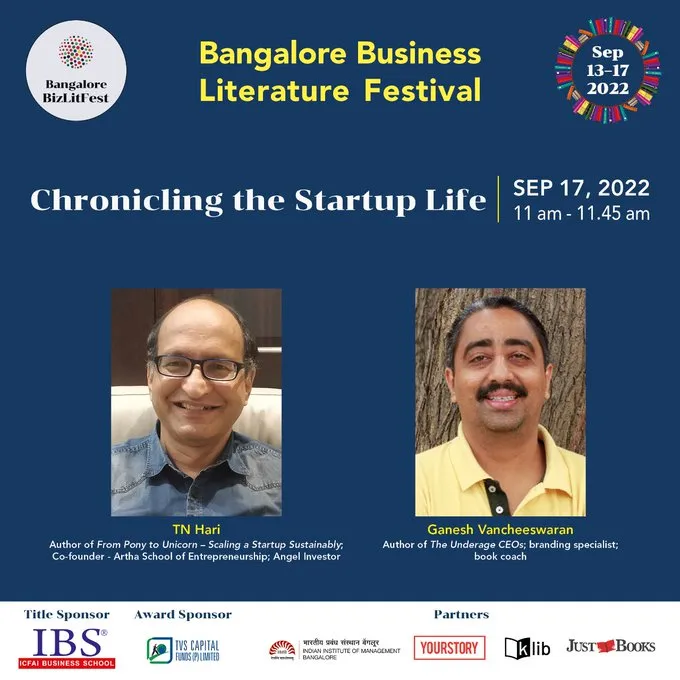Tech, design, behaviour—Bangalore Business LitFest provides a treat of conversations and insights
YourStory is the media partner for the Bangalore Business Literature Festival this week. In this preview article, we share a range of perspectives from five speakers.
Data storytelling, technology control, AI ethics, sustainable design, and consumer behaviour will be some of the issues highlighted at the Bangalore Business Literature Festival (BBLF) this week. See our earlier annual articles on BBLF from the 2015 edition onwards here, and our compilation of 85 Quotes on World Book Day.
See also YourStory’s Book Review section with takeaways from over 340 titles on creativity, entrepreneurship, innovation, social enterprise, and digital transformation.
In our fifth preview article on BBLF 2022, we share insights from five speakers on communication, human-machine co-existence, big tech regulation, behavioural nudges, and sustainable habitats.

Data and storytelling
Readers and writers sometimes face challenges in grasping and describing quantitative data. Techniques like data storytelling can help here.
“The challenge is for the storytellers to communicate more effectively. Hans Rosling is a good example of an author who has told data stories most effectively,” observes Govindraj Ethiraj, Founder of BOOM FactCheck and IndiaSpend.org.
“Data helps in presenting points more articulately, argue more coherently, and reach a higher elevation in our conversations—whether among friends or the larger public,” he adds.
For example, seeing videos of waterlogged roads in some areas but not in others doesn’t convey enough information. “Data on rainfall over, let's say, the last two to three decades should tell you that what we are seeing is unprecedented,” Govindraj explains.

Technology, control and balance
With technology increasingly creeping into our lives, issues of co-existence or dominance are getting discussed more widely.
“Some common views on human-machine co-existence are ponderings—which are useful in their own way. But most are gloom and doom predictions which have been alive since time immemorial. These are a waste of time,” observes Siddharth Pai, author of Techproof Me: The Art of Mastering Ever-Changing Technology.
A lot of concern has emerged around the role of big tech business models and their adverse impact on society. “Regulate Big Tech. Now. Globally,” Sid emphasises.
There are also concerns about digital divides with successive waves of technology. “Most of the digital divide would have been bridged in five to ten years. Where it hasn’t (mainly on the old/young vector), it will deepen and be exploited as the world ages,” he explains.

Digital media and ethics
The rise of utopian or dystopian views of tech futures also throws up issues of ethics, governance, and regulation.
“A full utopian or a full dystopian prediction is too easy and won't likely happen,” observes John C Havens, author of Heartificial Intelligence: Embracing Our Humanity to Maximise Machines.
“The predictions of robots coming to take our lives are already outdated in terms of humans not being able to control our data and not being told how precious our identity and values are. So robots actually physically killing us is a big deal, sure, but unless consumerism and advertising change drastically regarding data we're already in dystopia,” he cautions.
John is also the Sustainability Practice Lead, IEEE Standards Association, and Executive Director, The IEEE Global Initiative on Ethics of Autonomous and Intelligent Systems. As useful resources, he points to the IEEE website on Ethics in Action, where the report Ethically Aligned Design can be downloaded.
At a global level, John cautions against focusing only on economic growth and technology without prioritising the planet and people. “In terms of the metaverse, there's lots of great stuff that can happen there but only if we own or at least have access to our data,” he adds.
“Otherwise, Meta is an extension of Facebook and they've proven dozens of times over that they are proactively harvesting people for their data for the core business model. In ten years, we will spend a lot more time in the metaverse and ignore the planet more if we don't shift our outdated and harmful growth-first economic global mindset,” he cautions.

Consumer behaviour
From the urban environment to online communication, techniques like nudges have been used to influence citizen behaviour.
“Trends in behavioural economics are usually slow in emerging, as most things in the sociological or behavioural world,” observes V Raghunathan, author of over 15 books on management and culture, including Irrationally Rational, Games Indians Play, and Ganesha on the Dashboard.
He cites the example of NITI Aayog’s Behavioural Economics cell, which was launched in 2021 to make effective use of nudges in effecting changes in people’s behaviour. “Similarly, in Bengaluru, the traffic police set up mannequins dressed as traffic police at junctions to nudge people’s behaviour towards better compliance,” he adds.
“Some activists similarly installed large fibreglass crocodiles to draw attention to the menace of innumerable potholes in the city,” Raghunathan says.
Health warnings on cigarette packs, road signs, and labelled garbage bins are other varieties of nudges. He sees behavioural shifts in the merging of physical and digital worlds through examples such as augmented reality, robotic intelligence, and automated mobility.
“There are a variety of options available when it comes to nudges,” Raghunathan explains. These can include ticking clocks to modify people’s behaviour against ecologically unsustainable behaviour, or changing the architectural landscape to create an unconscious bias towards unhealthy options.
“On hate speech, for instance, one could show a child squirming or questioning parents when they engage in hate-mongering, as a powerful nudge against hate speech and hate crimes,” he affirms.
“How responsible media incentivise decent comments and disincentivise hate comments can play a significant role. In one of my blogs, for example, one of the trolls indulged in the filthiest possible language involving fornication,” Raghunathan recalls.
“I wrote to the editors stating that if they did not endorse such hate speech, they should delete that comment from their site. But they did not. Clearly, the incentives there were not quite right for taming hate speech,” he laments.

Architecture and environment
While a lot of digital advancement has focused on smart cities and habitats, there is more to sustainability than pure tech.
“India is well poised for smart building and smart city technologies and can become a leader. India has talent and expertise,” observes architect-designer Vijaya Bhargav, Partner at Ostraca.
“It is not just about focusing on technology but getting the basics right. Smart thinking, good design, and planning with a focus on people, place and the planet is the key. Heritage, culture, image and identity are important aspects as well,” she adds. Implementation challenges lie in tackling bureaucracy, she cautions.
She calls for more effective planning for smart and sustainable cities. “We need walkable and liveable cities. For this, we should look towards adopting the ‘half city’ concept. As smart individuals we should think of consuming half as much of everything we do,” Vijaya urges.
“That helps create cities that are greener, cleaner, with less traffic and less pollution as we did during COVID-19. We need to rethink our cities and re-purpose our built environment,” she emphasises.
As encouraging signs, Vijaya points towards some residential developments that foster living with nature and encourage biodiversity in the true sense. “There are a few examples of mixed-use developments that are sustainable models. The Titan Campus in Bengaluru sets a great example for future workspace buildings,” she adds.
Her own work addresses upgrades of government schools and urban interventions to create usable public spaces. As for rural architecture, Vijaya flags trends like going back to the roots of vernacular architecture by the usage of local materials, better hygiene, and self-sustainable models.

Tips for changemakers
The speakers also offer tips for game-changers and changemakers in terms of mindset, communication and connection.
“Think of how we can improve the quality of public discourse. In most issues, we can all accept some base data as a starting point even if we disagree on its interpretation. This in itself is a very important start,” Govindraj Ethiraj advises, on the importance of data stories.
“Always be kind. Everything else follows automatically,” Sid Pai adds.
Vijaya urges the creative community to dream big but respect the planet. Change is a constant, and it is important to upskill, update and reboot regularly.
“Believe that you can make a difference, leave a legacy that you will be proud of. Be empathetic. Collective intelligence can create wonders,” she signs off.
Edited by Kanishk Singh




![[Year in Review 2021] Top ten changemakers of the year](https://images.yourstory.com/cs/5/79900dd0d91311e8a16045a90309d734/collage1-1639488579193.png?fm=png&auto=format&h=100&w=100&crop=entropy&fit=crop)
![[Year in Review 2021] How women entrepreneurs pivoted during the pandemic and saw tangible results](https://images.yourstory.com/cs/4/8e7cc4102d6c11e9aa979329348d4c3e/Cover-05-1639653048479.png?fm=png&auto=format&h=100&w=100&crop=entropy&fit=crop)

![[Year in Review 2021] 10 inspiring stories of people who made the world a better place](https://images.yourstory.com/cs/5/a09f22505c6411ea9c48a10bad99c62f/Imageha73-1640855877602.jpg?fm=png&auto=format&h=100&w=100&crop=entropy&fit=crop)




